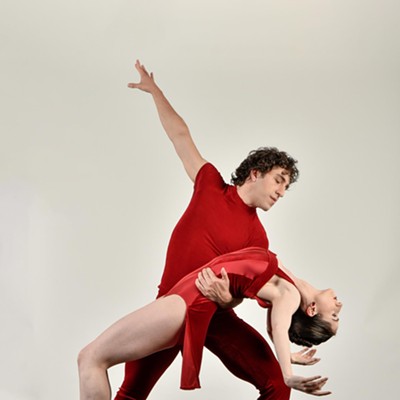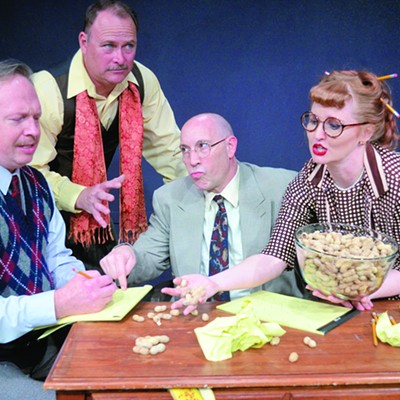The Spoils of War
The Fall of Europa Screening and Discussion2 p.m. and 7 p.m., Sunday, Feb. 10
Jewish Community Center
3800 River Road
299-3000; tucsonjewishfilmfestival.org
While the Nazi monstrosities during World War II are infamous, the plundering of historic artwork isn't as well-known. It wasn't until 2000 that Germany's then-cultural minister, Michael Naumann, launched the Lost Art Internet Database to increase awareness and recovery of the pirated works. The site has catalogued more than 3 million pieces of art stolen during the Third Reich.
The Fall of Europa is a documentary that chronicles the history of this stolen artwork and also explores Hitler's early artistic aspirations that led to so much theft. One of the many aspects covered in the film is the attempted recovery of the stolen artwork during the war: That was the job of the "Monuments Men."
After heavy lobbying from art organizations, the U.S. government created the Monuments, Fine Arts and Archives branch in 1943. The branch spawned the Monuments Men, soldiers whose original job was protecting monuments and artifacts. The group later was assigned to recover as much of the artwork as possible.
One of the few remaining survivors of the group is Harry Ettlinger. Born in Germany, Ettlinger's Jewish family found refuge in the United States. But after only seven years in the United States, at the age of 19, Ettlinger was sent back to Europe as a U.S. soldier. Ettlinger is visiting Tucson for a discussion at the Jewish Community Center following each screening of the documentary, where he'll discuss his efforts to recover massive amounts of artwork from salt mines.
"You can see a film and be entertained by it, but if you actually have someone from the film, it makes it so much more real," says Stuart Shatken, a volunteer for the Jewish Film Festival.
The film has not yet been released nationally. Tickets are $8 for adults and $6 for seniors and students. --M.K.
Wild Nights
Street-Prov10:30 p.m., Saturdays, through March 1
Live Theatre Workshop
5317 E. Speedway Blvd.
327-4242; street-prov.com
A night of drinking can lead to bad things. But in the case of Anthony Fama, it led to the reunion of a few friends and a resurgence of doing what they love to do--improv.
The three friends made it into a ritual. For two months, they got together, had a few drinks and took to the streets, doing improv for an audience of passers-by. Taking the apt name of Street-Prov, the group--with an expanded roster--went from the streets to the stage and is now making its first run at the Live Theatre Workshop as part of the theater's late-night Etcetera series.
Despite the press release that describes "general chaos" and "whatever ruckus (they) feel like causing," Fama says the evening is a "more controlled form of anarchism." Sketches take nearly 30 minutes and are performed in a way so that the audience "can take them and piece things together," Fama says.
The opening involves a monologue from a special guest that the performers use as inspiration for their improvisation. Titled "The Armando Diaz," named after the accomplished instructor and improviser, the opening will set the night into motion. Audience suggestions are used for the second format and create the scene for another long-form improvisation.
But don't get this confused with the comedy of Ryan Stiles and Colin Mochrie. "This isn't anything like Whose Line Is It Anyway?" Fama says.
Long-form improv typically includes interrelated scenes that are connected through theme or character. Although the message at a Street-Prov performance may not be immediately discernable, there is a meaning hiding somewhere underneath all the anarchy.
Ticket are $8 to $11. --M.K.
The Golden Age of Short Film?
TucsonFilm.Com Shortfest7 p.m., Saturday, Feb. 9
Crossroads 6 Grand Cinemas
4811 E. Grant Road
327-7067; tucsonfilm.com
The short film, like the oft-overlooked short story, has not been getting its due.
At least the short story can nostalgically hark back to the pre-sitcom, Saturday Evening Post good old days when novelists like Fitzgerald and Steinbeck supported themselves by pounding out short stories. But the short film doesn't have much of a history, except for the early days of cinema, when the first grainy black-and-white silent films faced practical time constraints arising from primitive film technology.
Ironically, advances in technology may pave the way for the short film's future.
"Short films are really hitting their own right now," says Mike Rom of TucsonFilm.com, which hosts an annual short-film festival, now in its third year. "The editing equipment is so cheap. All you need is a Macintosh and a camera."
Though TucsonFilm.com ShortFest organizers say "special attention is given to ... Arizona filmmakers," the festival receives submissions--all 15 minutes or shorter--from all around the globe. "We get an even mix," says Rom, "about half and half." Reflecting this mix, the ShortFest awards two prizes: Best in Show and Best of Arizona. The audience votes on winners after all finalists are screened. Past films and filmmakers featured at the ShortFest have gone on to national recognition, most notably the Oscar-winning short film West Bank Story.
Rather than lament its position as the feature-length film's bastard little brother, the short-film world should perhaps revel in its exile to underground cool, a place that allows filmmakers room for experimentation, free from the shackles of Hollywood's bottom line.
Tickets to the festival are $10 and will go on sale at the box office an hour before the festival; with only 350 seats available, early arrival is recommended. --A.M.
A Crisis of Adaptation
"Environmental Perspectives" Lecture Series: Alison Hawthorne Deming7 p.m., Thursday, Feb. 7
UA Library Special Collections
1510 E. University Blvd.
307-2781; library.arizona.edu
Award-winning poet and essayist Alison Hawthorne Deming knows the desert intimately. The UA professor lives on the northeastern edge of Tucson and writes in a small wooden cabin overlooking the perimeter of the city.
"I love the desert for its beauty, openness and strangeness," she says, "for the weird adaptive strategies of its flora and fauna."
But adaptation has its limits. "Everyone knows by now that the whole planet is in danger, but it's hard to see and feel ... the consequences," she says. Groundwater depletion is occurring underground; ozone is thinning far overhead; and global warming is imperceptible in our daily lives.
Alison's writing transcends mere celebration of the desert by voicing a poetic and informed call for reform. "There's a power for change in the meeting of science, art and advocacy," she says when asked about the intersection of environmentalism and the arts. "Information is boring and overwhelming, but stories are interesting and can be galvanizing."
Though deeply concerned, she remains optimistic. But in order for the desert to survive unaltered, humans will have to prove as adaptive as the cacti and coyotes. "We're very inventive creatures and can invent our way out of all kinds of danger and folly."
As a featured speaker in the UA Library's Environmental Perspectives Series on the appreciation of arid lands, Deming will give a free reading from her upcoming book, which she describes as "a bestiary for the 21st century," accompanied by a book-signing, a question-and-answer session and an exhibit of work by various other environmental writers. --A.M.







